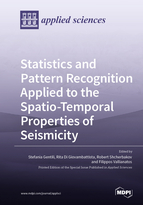Statistics and Pattern Recognition Applied to the Spatio-Temporal Properties of Seismicity
A special issue of Applied Sciences (ISSN 2076-3417). This special issue belongs to the section "Earth Sciences".
Deadline for manuscript submissions: closed (31 December 2021) | Viewed by 17834
Special Issue Editors
Interests: statistical seismology; source parameters; seismic catalogues; artificial intelligence
Special Issues, Collections and Topics in MDPI journals
Interests: statistical seismology; earthquake physics; source parameters; seismic catalogues
Interests: statistical seismology; earthquake physics; aftershocks; nonlinear geophysics; continuum mechanics; geomechanics
Interests: geophysics; earth physics; seismology; applied geophysics
Special Issues, Collections and Topics in MDPI journals
Special Issue Information
Dear Colleagues,
In recent years, there has been significant progress in understanding scaling laws, spatiotemporal correlations, and clustering of earthquakes, with direct implications for time-dependent seismic hazard assessment. New models based on seismicity patterns, considering their physical meaning and their statistical significance, have shed light on the preparation process before large earthquakes and on the evolution of clustered seismicity in time and space. On the other hand, increasing amounts of seismic data available on both local and global scales, together with accurate assessments of the reliability of catalogues, offer new opportunities for model testing.
This Special Issue focuses on emerging methods to improve our understanding of the physical processes responsible for the occurrence of earthquakes in space and time, on new models, techniques, and tools for quantifying both the seismotectonic processes and their evolution. It also focuses on new approaches and procedures to improve the analysis and processing of seismic catalogues including machine learning techniques.
Dr. Stefania Gentili
Dr. Rita Di Giovambattista
Dr. Robert Shcherbakov
Prof. Filippos Vallianatos
Guest Editors
Manuscript Submission Information
Manuscripts should be submitted online at www.mdpi.com by registering and logging in to this website. Once you are registered, click here to go to the submission form. Manuscripts can be submitted until the deadline. All submissions that pass pre-check are peer-reviewed. Accepted papers will be published continuously in the journal (as soon as accepted) and will be listed together on the special issue website. Research articles, review articles as well as short communications are invited. For planned papers, a title and short abstract (about 100 words) can be sent to the Editorial Office for announcement on this website.
Submitted manuscripts should not have been published previously, nor be under consideration for publication elsewhere (except conference proceedings papers). All manuscripts are thoroughly refereed through a single-blind peer-review process. A guide for authors and other relevant information for submission of manuscripts is available on the Instructions for Authors page. Applied Sciences is an international peer-reviewed open access semimonthly journal published by MDPI.
Please visit the Instructions for Authors page before submitting a manuscript. The Article Processing Charge (APC) for publication in this open access journal is 2400 CHF (Swiss Francs). Submitted papers should be well formatted and use good English. Authors may use MDPI's English editing service prior to publication or during author revisions.
Keywords
- Physical and statistical models of earthquake occurrence
- Earthquake clustering
- Quantitative testing
- Earthquake catalogues
- Time-dependent hazard
- Earthquake forecasting
- Model testing
- Pattern recognition in seismology
- Machine learning applied to seismic data
- Uncertainty quantification methods









